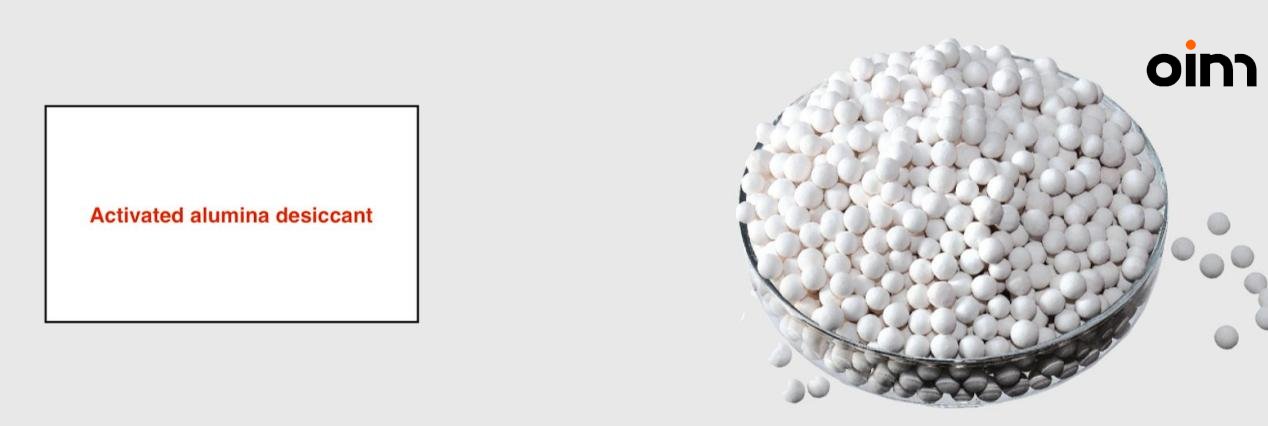Activated Alumina regeneration and attention
2022-09-22
Recently one of our customers asked whether your activated alumina can be used to dry acetylene? If it is used for a certain period of time and the water adsorption capacity is found to be weak, can it be recycled or regenerated? In response to these issues today, OIM Chemical will introduce the application, regeneration methods and precautions of activated alumina for you.

Q1: The application for activated alumina
First, let's answer the customer's first question. The main use of activated alumina is as an adsorbent. Because activated alumina has a strong adsorption for water, it has a wide range of effects on gas drying. The gases that can be dried with activated alumina mainly include: acetylene, cracking gas, coke oven gas, hydrogen, oxygen, etc. Since activated alumina releases a lot of heat when it absorbs water, it should be designed in combination with drying capacity, drying speed, heat exchange and other regeneration methods. So whether the customer said it is used for drying acetylene gas, the answer is yes.
Of course, our activated alumina also has other applications, such as: drying in air compression dryer, defluorinating agent for high-fluoride drinking water, dechlorinating agent for circulating alkane in alkylbenzene production, drying in petrochemical industry, Hydrogen peroxide production, removal of TBC, etc.
Q2: In the process of use, it is found that the water adsorption is reduced. How should we regenerate it?
In the drying application of activated alumina, heating regeneration is usually used, and hot nitrogen is usually used for purging regeneration. This is because of the strong interaction between water and activated alumina. It is difficult to completely desorb with other methods. The heating and desorption process consists of three steps: heating, flushing and cooling. The higher the heating temperature, the better the desorption and regeneration effect. The heating regeneration temperature of activated alumina is generally 180~350°C. Typically, the temperature of the activated alumina column is raised to 280°C and maintained for 4 hours at a heating rate of about 50°C per hour. Since high concentration of water vapor at high temperature will seriously damage the structure of activated alumina, the activated alumina bed must be flushed with nitrogen, air or other suitable gases while heating. The flushing gas should be as free of water as possible, because the water content of the flushing gas directly affects the regeneration effect.
The regenerated activated alumina bed must be cooled prior to the adsorption operation. When flushing the bed with cooling gas, the gas used should also be as free of water as possible, and the flow direction of the cold stripping gas should be the same as that of the adsorption cycle. When activated alumina is used to dry liquids, such as propylene, the liquid in the activated alumina bed must be drained first during the regeneration process without any dead ends. Otherwise, the residual liquid will react or carbonize when heated, which will seriously affect the adsorption cycle efficiency and operating life.
Activated alumina regeneration precautions, the specific surface area of deactivated activated alumina will be greatly reduced. The main reason is that activated alumina absorbs a large amount of adsorbed substances (water, organic matter, lye and other trace substances, etc.). In the working fluid, the internal pores of activated alumina are partially or completely blocked. The internal structure has undergone major changes, resulting in a denser structure than before. The internal pore size disappears or becomes smaller, resulting in the reduction of the specific surface area of activated alumina.
If you want to regenerate activated alumina, then you need to pay attention to the regeneration of waste activated alumina, the calcination temperature is 550°C, the holding time is 2 hours, the specific surface area is 242.2 m2/g, and other physical quantities are also active. Within the standard range of alumina, the activity at this time is high. However, the temperature for the treatment of waste activated alumina cannot exceed 800°C and exceeding this temperature will cause the activity of waste activated alumina to fail to recover. Because the higher the calcination temperature, the smaller the specific surface area. When the calcination temperature is the same, the specific surface area of activated alumina after regeneration decreases with the increase of the calcination temperature.
If you still need to know more about activated alumina balls, please feel free to contact us via email as below:
info@oimchem.com
sales@oimchem.com
